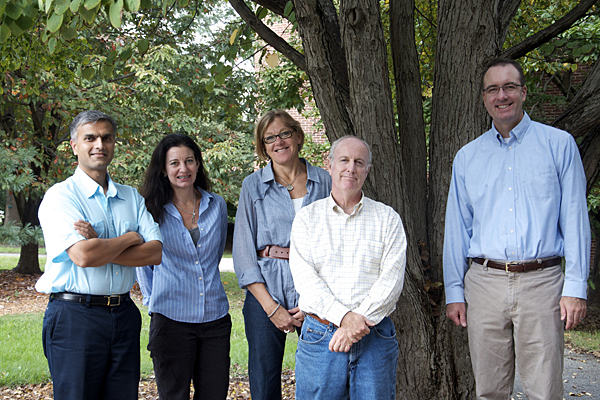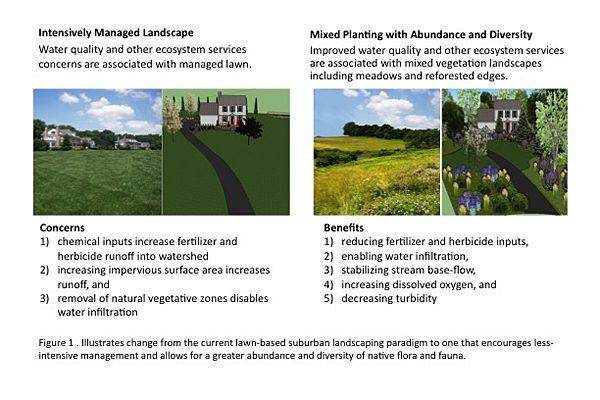


Lawns and water quality
UD professors gear up for study on lawns, water quality and ecosystem services
11:58 a.m., Oct. 6, 2011--Taking a fresh look at water quality management, a University of Delaware College of Agriculture and Natural Resources (CANR) research team is studying how the replacement of urban lawns with more diverse vegetation can help protect the environment and make our landscapes more sustainable.
The researchers have been awarded a $595,000 grant by the U.S. Department of Agriculture (USDA) and will be working at the Winterthur Gardens on their project.
Research Stories
Chronic wounds
Prof. Heck's legacy
Shreeram Inamdar, CANR associate professor of plant and soil sciences, is the principal investigator and the research team includes Doug Tallamy, chair of the Department of Entomology and Wildlife Ecology; Susan Barton, associate professor in the Department of Plant and Soil Sciences and a Cooperative Extension specialist; Jules Bruck, assistant professor of landscape horticulture and design; and Joshua Duke, professor in the Department of Food and Resource Economics.
One of the main goals of the three-year study, funded through the USDA's National Institute of Food and Agriculture (NIFA) National Integrated Water Quality program, is to try to curb water pollution at its source -- preventing pollution in the first place rather than waiting to treat contaminated water before it enters waterways.
“In the past, standard water quality management has focused on intercepting dirty water before it gets into water systems,” explained Tallamy. “We’re doing the opposite -- we’re trying to keep the water clean from the start.”
The researchers believe this can be accomplished by shrinking the lawn and replacing it with more diverse vegetation, thus reducing fertilizer and herbicide inputs and enabling water filtration, which will lead to less storm water runoff and cleaner water.
Diverse vegetation also is expected to provide other natural ecosystem services -- such as carbon sequestration, preserving biodiversity and natural pest control -- that are associated with mixed vegetation landscapes.
Inamdar noted that the ability to look at both of these aspects is a unique opportunity for the researchers. "One of the great things on this proposal is that we get to look at water quality as well as ecosystem services," he said. "Not many projects take that view, so I think that’s a very novel approach."
To conduct the study, the group will be comparing watersheds with different vegetation types at Winterthur.
Barton explained that the group will look at runoff from different types of watersheds at Winterthur -- one site will be a mown turf field that will be managed in the manner of a residential lawn and the other will be primarily forest and meadow.
By doing this, Barton explained, “We can directly compare these two streams, which are very close to each other, under the same weather conditions. One gets the residential lawn runoff and one gets the diverse landscape runoff.”
The team has also secured a local homeowner’s landscape for the research. Bruck said the property will be "used as a test garden, and will become a demonstration garden to show these different sustainable principles and practices.”
Barton noted that public tours of the sites will eventually be offered.
Planting will begin next spring and as soon as the team gathers enough information and data, it will provide educational courses at Winterthur to disseminate key information to the public.
Tallamy said that making this information readily available is an effort to “change the status symbol. Right now, the status symbol is a big lawn and we’re trying to make it more diverse.”
This is also one of the main focuses of the Center for Managed Ecosystems, of which Tallamy is the director.
Duke’s role will be to determine how much it would cost a homeowner to manage their property in a more diverse manner, as opposed to how much it costs to simply manage a big lawn. Said Duke, “We suspect that it might not be that lawn is actually the cheapest way to manage things. It may be that it’s cheaper for an owner to manage in a more sustainable manner; they might just not realize it because it’s not the status quo.”
Undergraduate and graduate students will be involved in many aspects of the research, from helping the group gather information on water quality, ecosystem services and the economic implications to helping in the design of the more sustainable garden.
Bruck explained that students in her Basic Landscape Design course will “work through the design process to come up with demonstration plans that will be presented to the University of Delaware Botanical Gardens (UDBG) and then we’ll post the plans on our website, for educational purposes for other homeowners.”
For now, the team is gearing up for the spring and ready to get the study under way, hoping to improve water quality and change the status quo from large lawns to diverse, more sustainable ecosystems.
Article by Adam Thomas
Photo by Danielle Quigley
Graphic courtesy Jules Bruck









